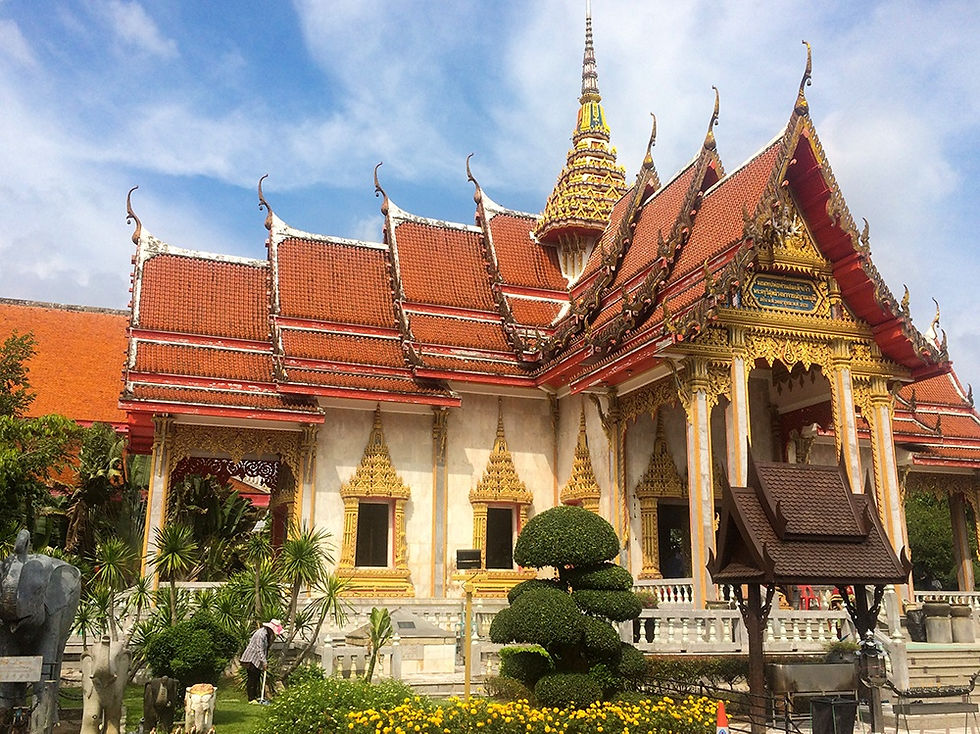Khao Sok National Park - Thailand’s Ancient Jungle
- Shannon
- Oct 7
- 5 min read
From Prehistoric Forests to Haunted Lakes
Officially protected in 1980, Khao Sok National Park spans over 739 square km's in Thailand’s Surat Thani Province. This vast expanse of wilderness is made up of a maze of limestone karst formations, lush jungle rivers and dense rainforest, all resting on what was once the floor of an ancient ocean. The park is home to one of the oldest evergreen rainforests on Earth, estimated to be over 160 million years old, predating even the Amazon and Congo rainforests. Its rugged terrain was sculpted over millennia by powerful tectonic shifts and relentless erosion, giving rise to the dramatic cliffs, valleys and hidden caves that make the landscape so striking today.

Before it was designated as a national park, the region remained largely untouched, its dense jungle and steep limestone cliffs making it difficult to access and inhospitable to largescale settlement. Despite its remoteness, there is compelling evidence of human habitation in the area dating back to prehistoric times. Archaeological discoveries, including ancient cave paintings, stone tools and pottery fragments, indicate that early inhabitants not only passed through but established small communities within the forest. These remnants offer a glimpse into a distant past, revealing that even this seemingly impenetrable wilderness has long been a part of human history.
During World War II, the mountainous jungles and hidden caves of Khao Sok provided a natural sanctuary for local villagers fleeing the advance of the Japanese Imperial Army. Seeking safety from the threat of forced labour or death, these villagers established temporary settlements deep within the forest, surviving by foraging, hunting and living off the land. The thick vegetation and difficult terrain offered both concealment and protection, making it nearly impossible for occupying forces to pursue them effectively. Decades later, in the 1970s, the forest once again became a refuge, this time for communist insurgents during a period of intense political unrest in Thailand. Despite this, the region’s wild, untamed landscape proved too challenging for sustained occupation or major infrastructure projects. Ironically, this very inaccessibility played a crucial role in preserving Khao Sok’s ecosystems, shielding it from waves of development and resource extraction that affected many other parts of the country.

In 1982, the Thai government completed construction of the Ratchaprapha Dam, a major hydroelectric project aimed at meeting the country’s growing energy demands. The dam’s completion led to the creation of the vast Cheow Lan Lake by flooding a deep valley within the boundaries of the National Park. As a result, several villages, temples and farmlands were submerged beneath the rising waters and the local population was forcibly relocated to make way for the reservoir. While the project was controversial due to its social and environmental impacts, the resulting lake eventually became one of the park’s most iconic and visually stunning features. Its emerald waters, dotted with dramatic limestone islets, now draw visitors from around the world. In addition to boosting eco tourism, the lake also plays a crucial role in funding conservation initiatives and supporting sustainable development within the region.
After the dam’s construction flooded the valley to form Cheow Lan Lake, one submerged village, now known as “the haunted village”, became the focus of many eerie stories. Locals recount divers and fishermen hearing whispers underwater, seeing flickering lights beneath the surface or feeling sudden chills despite the tropical heat. During dry seasons, the outlines of temple rooftops and treetops sometimes emerge from the lake, adding to the village’s ghostly reputation. These tales stem from the belief that not all spirits were at peace when their homes were lost to the waters, with some souls said to remain tied to the land.

The most famous legend of Khao Sok is the tale of Mae Nang Sok, a ghostly woman said to haunt the area around the Lake. Once a beautiful and innocent woman, she was cruelly accused of a crime she did not commit, some say betrayal, others suggest a stain on honour and despite her innocence, her own people condemned her to a brutal and unjust death. But her execution was no quiet end, it ignited a wrath so fierce that nature itself seemed to rebel. A sudden, devastating flood tore through the village, swallowing homes and lives alike, believed to be the unleashed fury of Mae’s restless spirit. Bound forever to the forest, her ghost is said to roam the shadows, a vengeful guardian of the land she once called home. Those who dare disrespect the forest, through destruction or harm, often find themselves victims of strange accidents, violent storms or an overwhelming sense of dread. Mae Nang Sok is not simply a ghost to fear but a relentless protector, a chilling reminder of the natural world’s raw power and the price of human cruelty.

Today, Khao Sok is managed by Thailand’s Department of National Parks, Wildlife and Plant Conservation. It is one of the most biologically diverse areas in Southeast Asia, home to over 300 species of birds, 48 species of mammals and hundreds of reptiles and amphibians. Notable residents include Asian elephants, gaurs, Malayan tapirs, barking deer and the elusive clouded leopard. Birdwatchers come in search of hornbills, while botanists are drawn to the rare Rafflesia kerrii, a massive parasitic flower that blooms only a few days each year and smells like decaying flesh.
Khao Sok National Park is far more than a breathtaking natural destination, it is a place where ancient geology, turbulent political history and rich cultural mythology intertwine. From its beginnings as a prehistoric coral reef to its role as a refuge during wartime and a beacon of environmental conservation, the parks story is deep and multifaceted. Whether you come to marvel at the soaring limestone cliffs, encounter rare wildlife or experience the haunting stillness of Cheow Lan Lake, Khao Sok invites visitors to look beyond the surface. It serves as a powerful reminder that nature holds both beauty & history and that every trail through the forest reflects the stories of the past as much as the life of the present.

🗺️ Location
Khao Sok National Park, Mu Phanom, Surat Thani, Thailand
🚆 How to get there
While it's totally worth the effort, this is a mission to get to! You'll first need to make your way to Surat Thani. From there, local buses run hourly from the train and bus stations between 6am - 4pm, leaving only when full, costing around 120 THB. Shared minivans depart Surat Thani bus station every hour during the same times for 250 THB and take about 2 hours. From Surat Thani Airport, you can pre book a shared minivan or arrange transfers on arrival, costing around 300 THB and taking roughly 2.5 hours. It is advisable to have your accommodation already organised, as they can pick you up once you reach Khao Sok’s entry gate. The hotel can also organise packages for access to Cheow Lan Lake and overnight stays in the water bungalows.
⭐ Attraction Info
Khao Sok National Park - Thailand’s Ancient Jungle charges an entry fee of about 300 THB per day for foreign adults and 150 Baht for children. Accommodation ranges widely from budget friendly ecolodges and treehouses to more upscale floating resorts. Many lodges offer multi-day packages that include guided jungle treks, lake tours and meals, typically starting around 6000 to 7000 THB per person for 3 to 4 day stays. Prices and packages vary, so it’s best to check directly with providers for the latest options and rates.
เขาสก
Thanks for reading about Khao Sok National Park - Thailand’s Ancient Jungle. Check out more awesome destinations here!
























